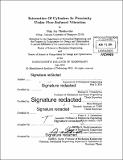Interaction of cylinders In proximity under flow-induced vibration
Author(s)
Thekkoodan, Dilip Joy
DownloadFull printable version (8.729Mb)
Other Contributors
Massachusetts Institute of Technology. Department of Mechanical Engineering.
Advisor
Michael S. Triantafyllou and Rémi Bourguet.
Terms of use
Metadata
Show full item recordAbstract
This study examines the influence of a stationary cylinder that is placed in proximity to a flexibly mounted cylinder in the side-by-side arrangement. The problem is investigated with an immersed-boundary formulation of a spectral/hp element based (Nektar-SPM) fluid solver. The numerical method and its implementation is validated with benchmark test cases of the flow past an isolated cylinder in both the stationary and flexibly mounted configurations. The study examines a parametric space spanning 6 center-to-center spacing configurations in the range 1.5D-4D and 13 equispaced reduced velocities in the range 3.0-9.0. The simulations are performed in two-dimensional space and the Reynolds number is held at 100. The response characteristics of the moving cylinder are classified into regimes based on the shape of the response curve and the variation of the r.m.s. lift coefficient. It is shown that the moving cylinder influences the lift and drag force characteristics on the stationary cylinder and the frequency composition in the wake. A detailed look at the frequencies and the relative strengths of the frequencies indicates a diminishing influence of the moving cylinder on the stationary cylinder, both with increasing separation and smaller amplitudes. By examining the wake patterns and monitoring the frequencies in the wake of each cylinder, the interference level is qualified and explained to be the basis of the different families of response.
Description
Thesis: S.M., Massachusetts Institute of Technology, Department of Mechanical Engineering, 2014. Cataloged from PDF version of thesis. Includes bibliographical references (pages 57-59).
Date issued
2014Department
Massachusetts Institute of Technology. Department of Mechanical EngineeringPublisher
Massachusetts Institute of Technology
Keywords
Mechanical Engineering.